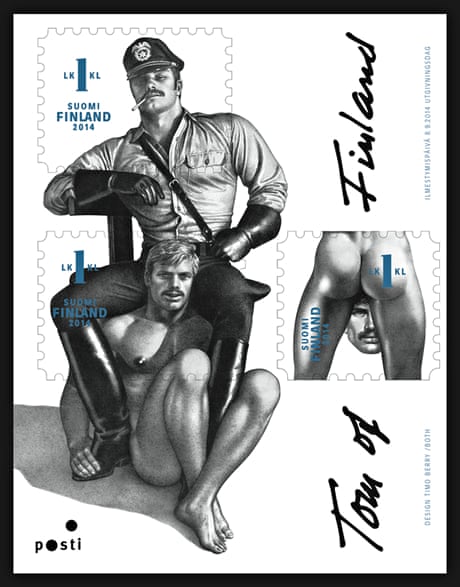A nipple, shapely buttocks and a muscular, moustachioed man smoking a cigarette – a new set of three stamps, to be issued in Finland in September, are among the most daring ever seen in the philatelic world. The images are by Tom of Finland, the legendary artist who was born in south-west Finland in 1920, and died in 1991. He created an archive of erotica with a distinct aesthetic – vast-shouldered men in leather, denim and knee-high boots – that is said to have influenced figures including Robert Mapplethorpe, Freddie Mercury and the Village People.
The male portraits on the Finnish stamps aren't the most explicit of the artist's work. His art very often pays tribute to a tumescence absent in the images chosen for these stamps. The Tom of Finland Foundation has said his early process often involved "locking himself in his room, stripping naked, and stroking himself with one hand while the other hand created on paper what he could seldom find on the streets".
Even so, they are considerably more erotic than those usually seen on any nation's envelopes. Dean Shepherd, editor of Gibbons Stamp Monthly, says that he has never seen homoerotic art on stamps before. Erotic art more generally? "No, it tends to be nude paintings reproduced on stamps, but as far as actual erotic art is concerned, I think this is the first time." There was a bit of a storm in the early 1930s, he says, when the Spanish Postal Authority approved some stamps featuring Goya's The Nude Maja – a woman reclining naked. The US government apparently barred and returned any mail that bore it.
Stamps represent a country, and are the most public of media, so they rarely feature strongly sexual subjects, says Matt Hill, editor of Stamp and Coin Mart. When paying tribute to LGBT culture, it's more usual for stamps to depict gay heroes.
In 2012, for instance, second world war codebreaker Alan Turing was featured in the Royal Mail's Britons of Distinction series, and in May this year, a stamp featuring Harvey Milk, one of the first openly gay elected officials in the US, will be launched with a ceremony at the White House. There is currently a campaign under way to honour gay civil rights activist Bayard Rustin with a stamp, and the Gay and Lesbian History on Stamps Club, founded in New York in 1982, highlights other notable gay people who have featured. These include the artist Andy Warhol, the writer James Baldwin and the poet Elizabeth Bishop.
In 2010, the Austrian Post Office issued a stamp commemorating the 15th Rainbow Parade in Vienna, but perhaps the most joyful of all stamps celebrating gay culture are those created for a kingdom not recognised by any government. A group of gay rights activists founded the Gay and Lesbian Kingdom of the Coral Sea Islands in 2004, in response to the Australian government's refusal to recognise equal marriage, and a post office was set up. In July 2006, nine stamps were issued, with symbols including a pink triangle, red ribbon and the International Bear Brotherhood Flag.

Comments (…)
Sign in or create your Guardian account to join the discussion